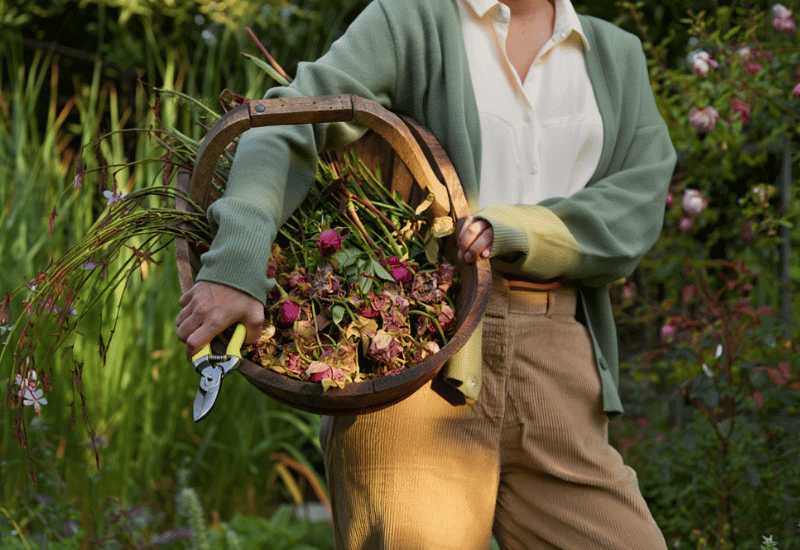
By October, we all start to feel it — the garden’s slowing down. The borders look a little tired, petals are fading, and you can almost hear the season sighing as it gets ready for its final bow. But if frost hasn’t found you yet, there’s still a window — and a few quick snips to remove those spent flowers — to wake things back up.
I know, I know. Deadheading in October sounds late. But trust me, it’s one of the easiest ways to squeeze a little more life — and color — out of your beds before winter settles in. In warmer zones, roughly 6 through 10, many perennials and flowering shrubs still have the energy to push out a final round of blooms before Thanksgiving. Roses, salvias, and coreopsis are quick to respond, often sending up fresh flowers just when the rest of the garden is fading.
Sure, these late blooms won’t be as full or showy as midsummer’s — they’ll be smaller, softer, more fleeting — but that’s what makes them special. They’re the garden’s quiet way of saying thank you before it goes to sleep for the winter.
In cooler zones, around 4 and 5, the payoff might be lighter — a few surprise blooms or a flush of fresh green growth — but even that keeps your beds bright instead of brown and brittle. A quick trim now also helps prevent disease and keeps plants healthy heading into the cold months ahead.
So if you’ve ever stood in your yard in October and thought, “I wish I could squeeze just a few more weeks of color out of this garden,” here’s your chance. These 11 plants don’t mind a little encouragement — and they’ll happily repay you with one last cheerful burst of bloom before the season calls it a wrap.
1. Roses (Rosa hybrids and shrub types)
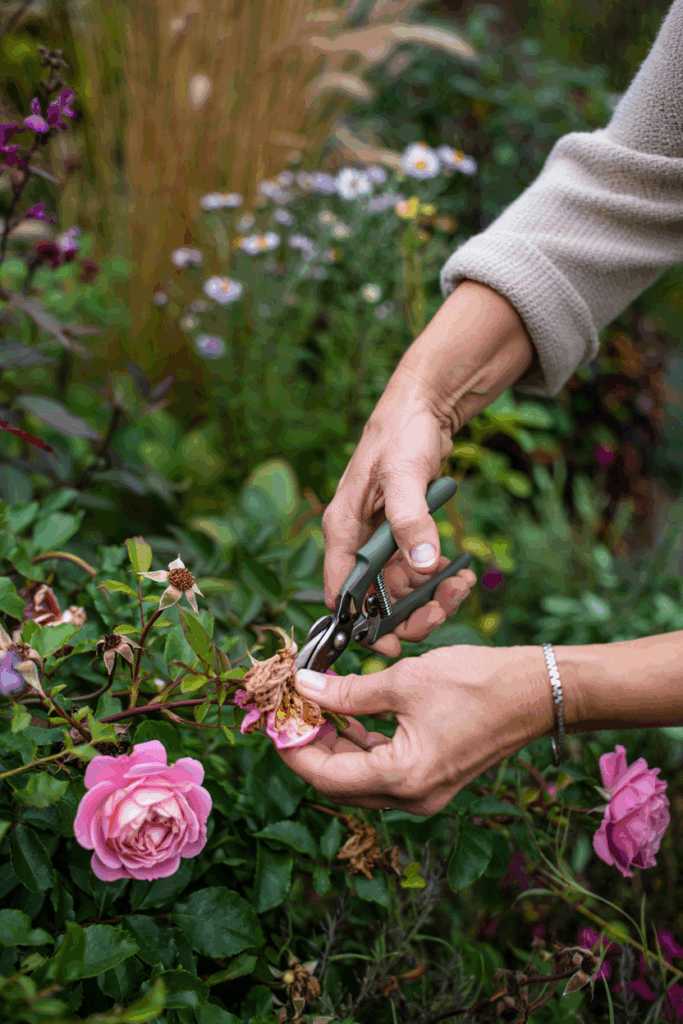
October doesn’t mean your roses are finished. In much of the U.S., especially in Zones 6 through 10, mild days and warm soil can keep repeat-blooming varieties flowering right up to the first hard frost. Roses respond to temperature and light more than the calendar, so with a few careful cuts, you can coax a final flush before winter sets in.
Once petals start to fade or droop, snip the stem just above a five-leaflet leaf that faces outward. That’s the point where the plant’s strongest bud sits — ready to send up new growth.
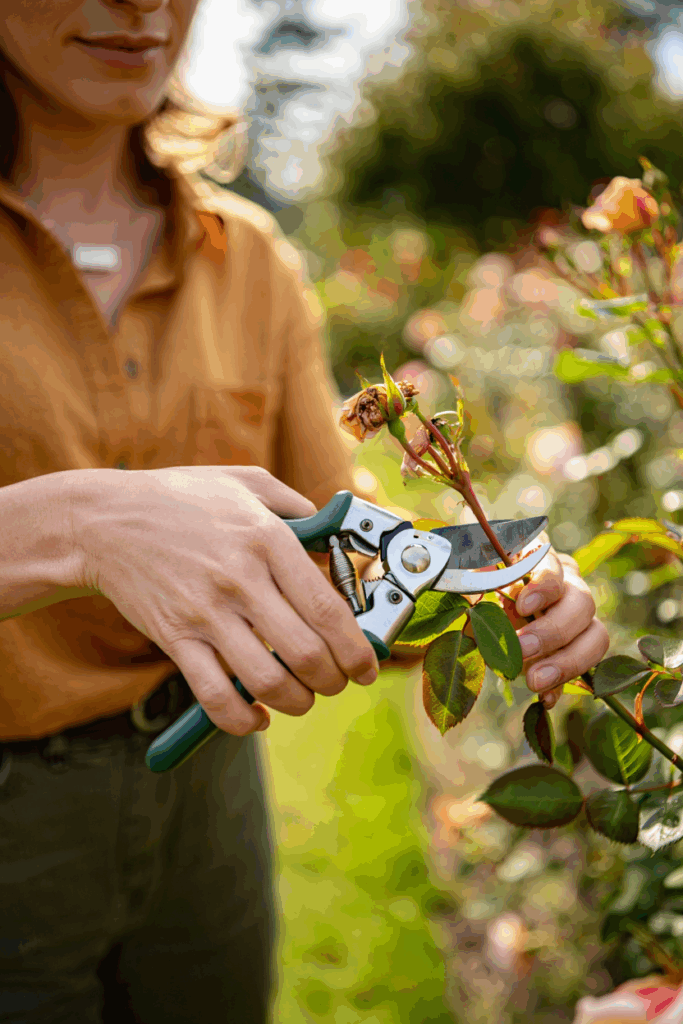
Cutting here encourages a sturdy stem and another bloom cycle, while cutting higher leaves weak, thin shoots that won’t have time to mature. In warmer regions, cultivars like ‘Knock Out’, ‘Iceberg’, ‘Belinda’s Dream’, and ‘Lady of Shalott’ often respond quickly, producing a lighter but vibrant round of color that lasts into November.
In colder climates (Zones 4 and 5), stop deadheading by mid-October. Allowing the last blooms to form hips signals the plant to slow down and harden its canes — a natural step toward winter dormancy. Late pruning or feeding after that point can trigger tender growth that frost will easily damage.
2. Salvias (Salvia greggii, S. microphylla, S. nemorosa)
If there’s one plant that loves a mid-fall haircut, it’s salvia. These dependable bloomers never seem to tire, and a light trim in October can wake them up for one last round of color before winter.
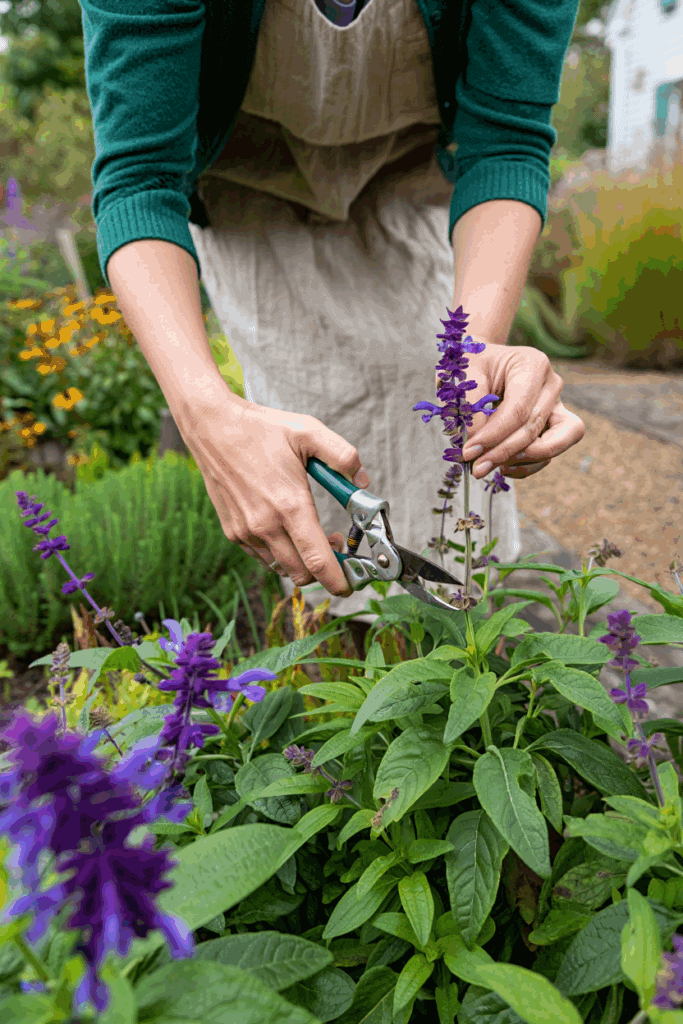
Look closely at your plants — once the flower spikes fade and the lower leaves start to look tired, take clean pruners and cut each stem back by about one-third, just above a pair of healthy leaves. This signals the plant to push fresh side shoots instead of going dormant. In warm, dry regions or near the coast, that gentle cut often brings a soft encore of blooms within two to three weeks.
For woody salvias like S. greggii and S. microphylla, keep the pruning light; they resent hard cuts this late in the year. Salvia nemorosa can handle a bit more, especially if it’s in Zones 5 through 8 where frost comes earlier. Stop trimming once consistent night temps dip into the 40s — at that point, let the plant rest and redirect its energy into root growth for winter survival.
3. Hardy Geranium (Geranium ‘Rozanne’, ‘Ann Folkard’)
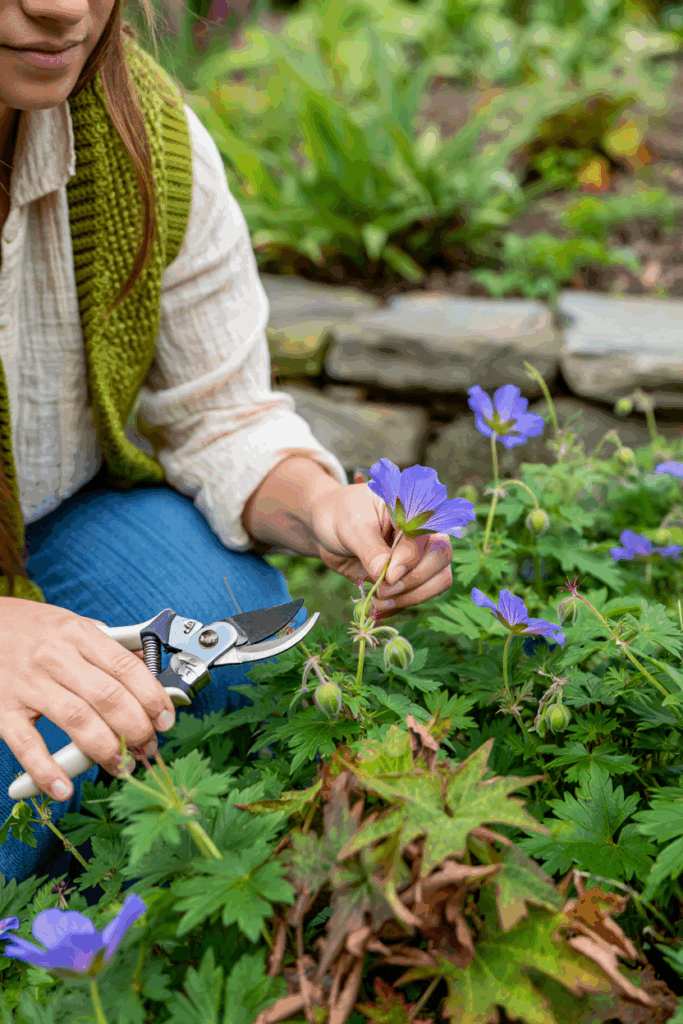
By the time October rolls around, hardy geraniums often start to look spent — the centers open up, stems flop, and the last few flowers fade. But these cranesbills are tougher than they look, and in much of the U.S., they still have enough energy left for one more show.
In most climates, a light shear now is all it takes to wake them back up. Use clean pruners to remove the top third of the plant, cutting just above healthy leaves. This encourages compact new foliage and can trigger a scattering of late-season blooms, especially in ‘Rozanne’ and ‘Ann Folkard’. Both cultivars are among the longest-blooming hardy geraniums, capable of flowering from late spring until frost in Zones 5 through 9.
In warmer regions (Zones 7–9), you can expect fresh growth and a second light bloom that lasts into November, particularly in coastal or mild inland areas. In cooler zones (5–6), trim by early October to give new foliage time to mature before frost sets in. The plant won’t produce a full flush of flowers there, but it will stay cleaner and healthier heading into winter dormancy.
4. Yarrow (Achillea millefolium)
By the time fall settles in, yarrow’s sturdy stems and faded flower heads can make borders look tired. But this is one perennial that still responds beautifully to a little attention in October — and in warmer parts of the country, it might even thank you with a surprise encore of blooms.
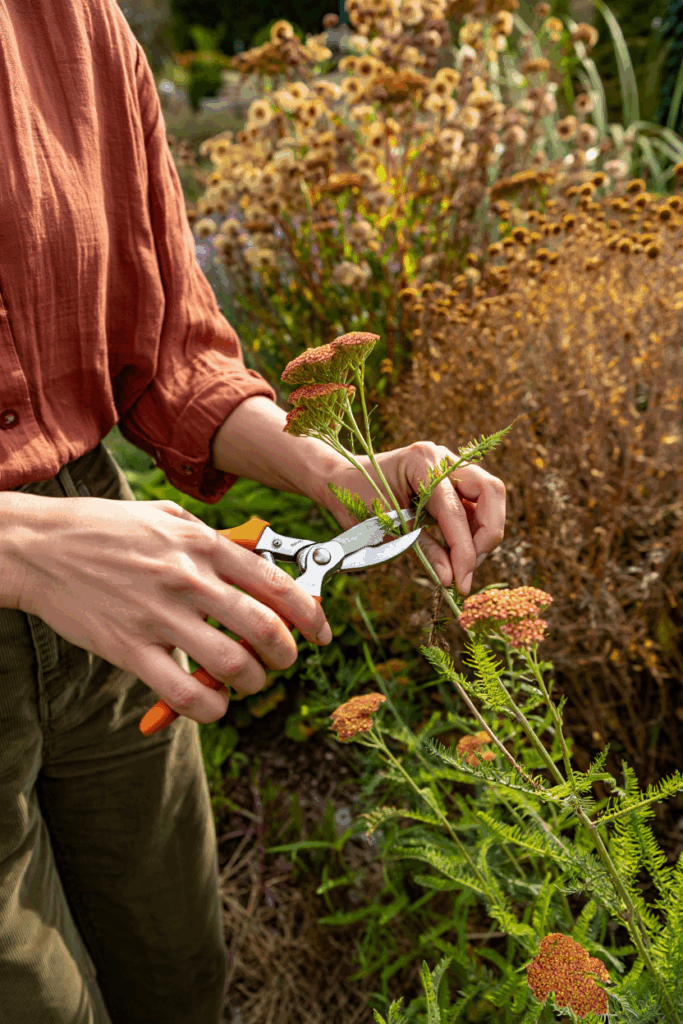
Once most flower clusters have turned brown, take clean shears and cut the stems back to about four inches above the basal foliage. That low, ferny growth is still active and helps feed the roots before winter, so don’t cut too far down. In mild regions — Zones 6 through 9 — warm soil and bright days often encourage new, smaller flower heads within two to three weeks, especially on prolific cultivars like ‘Moonshine’, ‘Terracotta’, and ‘Coronation Gold’.
In cooler areas, particularly Zones 4 through 5, you might not see a full rebloom, but this light trim keeps plants tidy and prevents self-seeding — something Achillea millefolium is famous for. It also cuts down on fall mildew and keeps the foliage fresh through early winter.
5. Rudbeckia (Rudbeckia . fulgida, Rudbeckia . hirta)

By fall, black-eyed Susans start to show their age — petals fade to parchment, seed heads darken, and the border loses that midsummer glow. But don’t count them out yet. A quick round of deadheading in October can coax these sturdy bloomers into one last burst of color before frost, especially in the right regions.
Take clean pruners and snip off spent flowers just above a healthy leaf node or side branch that’s still green and firm. That’s where dormant buds sit ready to push new growth. Avoid cutting into the basal foliage, which continues to feed the roots through fall. In warmer parts of the country — Zones 6 through 9 — this trick often brings on another scattering of bright daisies within two to three weeks, especially on long-blooming cultivars like ‘Goldsturm’ and ‘Viette’s Little Suzy’ (both R. fulgida var. sullivantii).
For short-lived types such as R. hirta (common black-eyed Susan), deadheading has two big advantages: it prevents rampant self-seeding and tidies up tired stems. Varieties like ‘Indian Summer’, ‘Cherokee Sunset’, and ‘Denver Daisy’ respond well if trimmed lightly above emerging side shoots, rewarding you with a few smaller, late blooms before frost.
In cooler northern zones (4–5), even if the plants don’t rebloom, this cleanup helps them harden off properly and reduces overwintering disease.
6. Foxglove Beardtongue (Penstemon digitalis, P. barbatus, and hybrids)
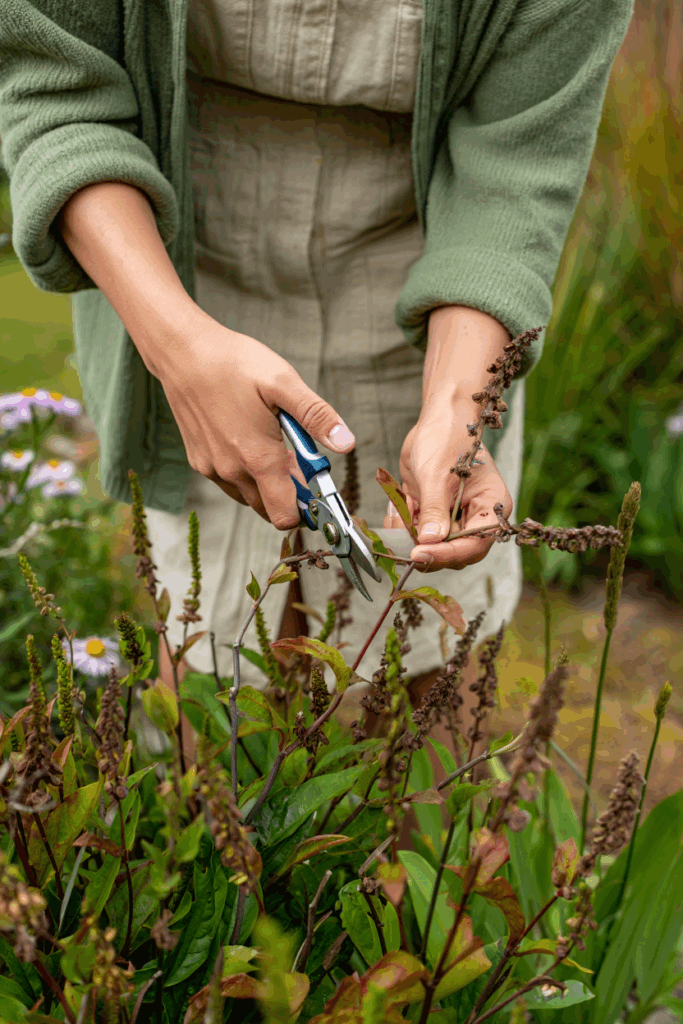
Penstemons are often winding down by October, but a little strategic deadheading can stretch their bloom season further than you’d think — especially in areas where fall stays mild. These tough perennials are programmed to keep flowering as long as temperatures hover above freezing and the soil stays warm.
Once the tall spikes finish flowering, cut them back to just above a pair of healthy leaves or a strong side shoot near the base. This directs the plant’s energy into new lateral growth instead of seed production. In warmer zones — roughly 6 through 9 — many varieties will push out another light flush of blooms that carry through late fall, particularly reliable performers like P. digitalis ‘Husker Red’, P. barbatus ‘Elfin Pink’, and P. × mexicali ‘Red Rocks’.
In cooler zones (4 through 5), deadheading won’t bring another bloom, but it still benefits the plant. It prevents self-seeding, reduces the risk of crown rot in damp fall weather, and keeps the clumps compact as they prepare for dormancy.
7. Gaura (Oenothera lindheimeri, formerly Gaura lindheimeri)

By October, gaura’s wispy wands of white and pink blooms start to tangle and fade, but don’t be fooled — this prairie perennial still has plenty of life left if you give it a quick refresh. In mild parts of the country, especially Zones 6 through 9, a light trim now can spark a graceful encore of flowers that last right up until frost.
Use clean pruners to snip away the spent flower stalks, cutting them back by about one-third to just above a strong leaf node or side branch. That small cut encourages new flowering stems from the base while maintaining the plant’s airy form. If your gaura has gotten leggy, you can go a bit lower — just avoid cutting into the woody base, which doesn’t resprout well this late in the season.
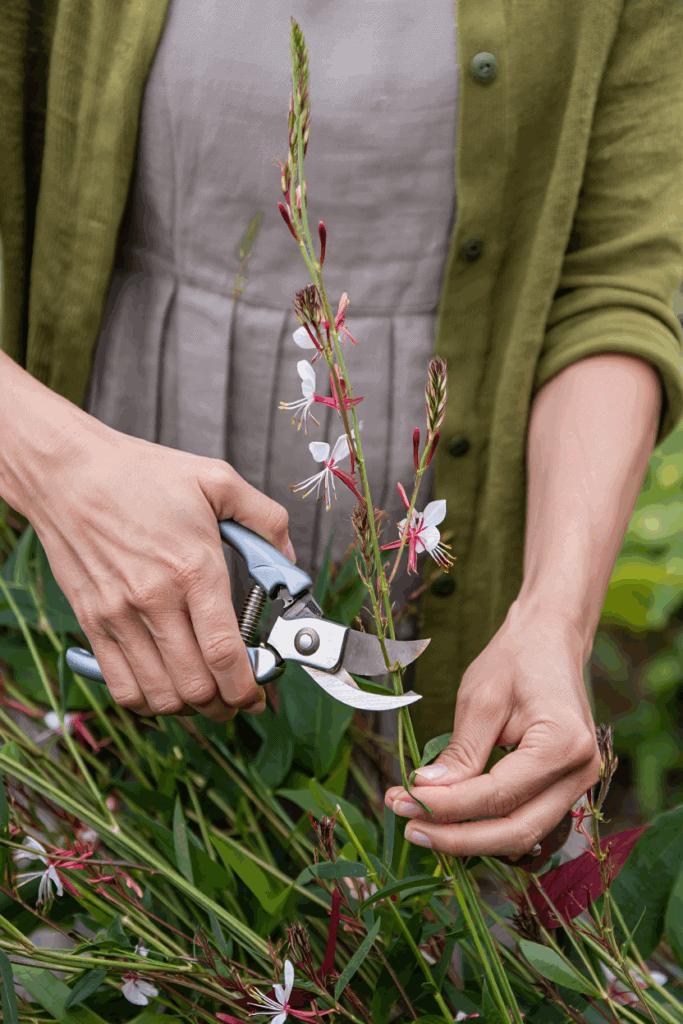
Varieties like ‘Whirling Butterflies’, ‘Siskiyou Pink’, and ‘Belleza White’ respond especially well to October deadheading, often sending up a lighter flush of blooms within two or three weeks if the soil stays warm. In cooler northern zones (5 and below), deadheading helps clean the plant up and prevents excess seeding, keeping clumps compact and tidy through fall.
8. Coreopsis (Coreopsis grandiflora, C. verticillata, C. lanceolata)

Tickseed has a well-earned reputation for blooming itself to exhaustion — but in most parts of the U.S., you can keep it going deep into fall with one last round of deadheading. By October, many clumps are dotted with seed heads and fading petals, yet the plants are still actively growing as long as days remain mild.
Take sharp pruners and cut back the spent stems by about one-third, trimming just above a healthy set of leaves. This redirects energy from seed production into new side shoots and buds. In warmer zones (6 through 9), that quick cleanup often brings on a smaller, second flush of golden blooms that can carry through November. Cultivars like ‘Moonbeam’, ‘Zagreb’, and ‘Early Sunrise’ are especially responsive, producing fresh flowers fast when soil temperatures stay above 55°F.
In cooler regions (Zones 4 and 5), you may not see much rebloom this late, but deadheading still pays off — it keeps plants neat, prevents unwanted reseeding, and helps the crown dry out between fall rains.
9: Pincushion flower (Scabiosa columbaria, S. atropurpurea)

By October, pincushion flowers may look a little tired, but don’t pull them yet — they’re often still capable of another short bloom cycle if the weather stays mild. Scabiosa is naturally long-flowering, responding to deadheading faster than almost any other perennial, especially in well-drained soil and full sun.
Take sharp pruners and remove faded blooms as soon as the petals wilt and the seed head begins to harden. Cut each stem back to a strong pair of leaves near the base of the flower stalk. This encourages the plant to push up fresh stems rather than wasting energy on seeds. In warmer regions (Zones 6–9), cultivars like ‘Butterfly Blue’, ‘Pink Mist’, and ‘Fama Deep Blue’ often reward this October cleanup with a scattering of new blooms that can last until the first hard frost.
In cooler climates (Zones 4–5), deadheading won’t trigger many new flowers, but it still helps prevent self-seeding and keeps the crown dry as fall moisture increases.
10. Erysimum (Erysimum × linifolium, E. cheiri)
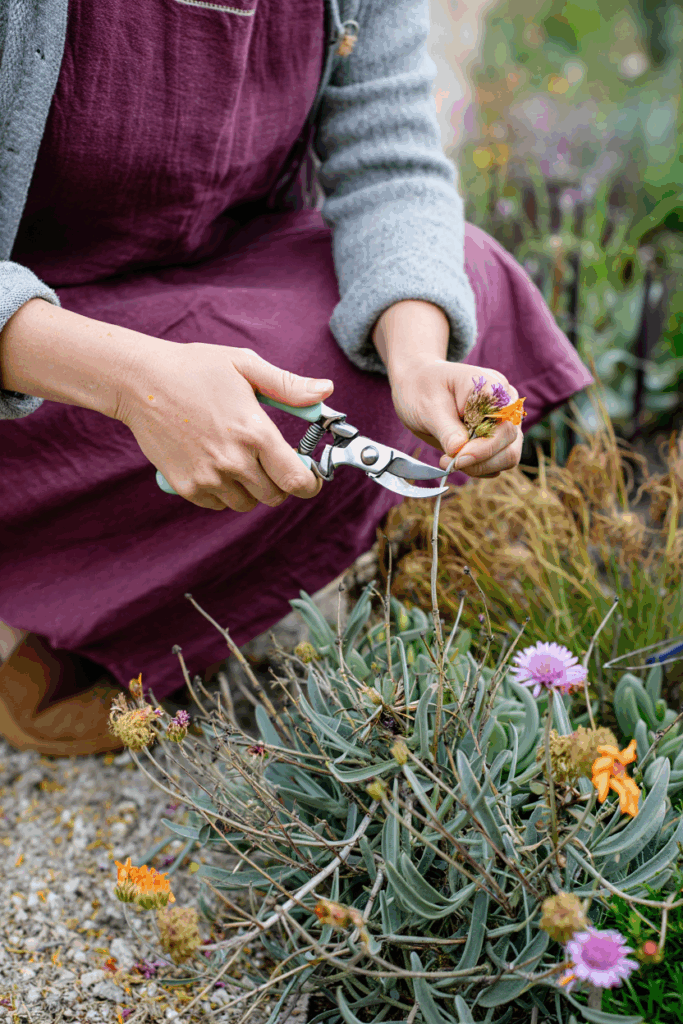
Wallflowers are famous for refusing to quit. Even in October, when most perennials are winding down, many Erysimums keep throwing out buds as long as the days stay bright and the soil hasn’t turned cold. A little light deadheading now keeps them blooming longer and helps the plants stay dense and healthy through winter.
Take clean pruners and clip away each faded flower stem, cutting just above a strong pair of leaves. Don’t cut into the older woody base — it rarely resprouts once hardened. In warmer parts of the country (Zones 7 through 10), cultivars like ‘Bowles’s Mauve’, ‘Winter Passion’, and ‘Poem Lavender’ often respond within a couple of weeks, sending up a new flush of mauve, peach, or yellow flowers that can last right through Thanksgiving in coastal and southern gardens.
If you garden farther north, in Zones 5 or 6, Erysimum behaves more like a short-lived perennial or biennial. Deadheading won’t trigger another bloom this late, but it’s still worth doing — it prevents the plant from exhausting itself setting seed and helps the foliage stay dry and disease-free through fall rains.

Written By
Amber Noyes
Amber Noyes was born and raised in a suburban California town, San Mateo. She holds a master’s degree in horticulture from the University of California as well as a BS in Biology from the University of San Francisco. With experience working on an organic farm, water conservation research, farmers’ markets, and plant nursery, she understands what makes plants thrive and how we can better understand the connection between microclimate and plant health. When she’s not on the land, Amber loves informing people of new ideas/things related to gardening, especially organic gardening, houseplants, and growing plants in a small space.
